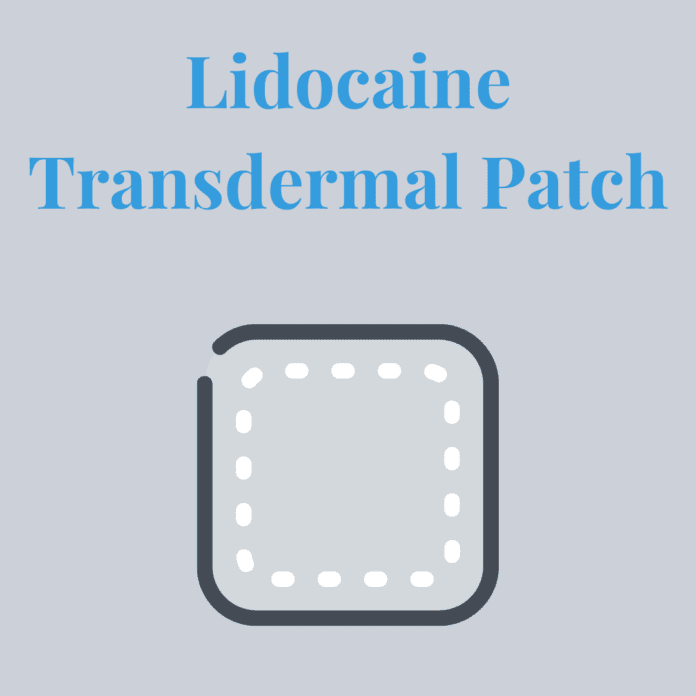Uses
Lidocaine transdermal patches are used to relieve the pain of post-herpetic neuralgia (PHN; the burning, stabbing pains, or aches that may last for months or years after a shingles infection).
Lidocaine is in a class of medications called local anesthetics. It works by stopping nerves from sending pain signals.
Side Effects Of Lidocaine Transdermal Patch
Lidocaine transdermal patches may cause side effects. If any of these symptoms occur, remove your patch and do not put it back on until the symptoms go away. Tell your doctor if any of these symptoms are severe or do not go away:
- burning or discomfort in the place you applied the patch
- redness or swelling of the skin under the patch
Some side effects of lidocaine transdermal patches can be serious. The following symptoms are uncommon, but if you experience any of them, call your doctor immediately:
- hives
- skin rash
- itching
- difficulty breathing or swallowing
- swelling of the face, throat, tongue, lips, eyes, hands, feet, ankles, or lower legs
- hoarseness
- cool, moist skin
- fast pulse or breathing
- unusual thirst
- nausea
- vomiting
- confusion
- weakness
- dizziness
- fainting
Lidocaine transdermal patches may cause other side effects. Call your doctor if you have any unusual problems while using this medication.
Warnings & Precautions
Before using lidocaine transdermal patches:
- tell your doctor and pharmacist if you are allergic to lidocaine; other local anesthetics such as bupivacaine (Marcaine), etidocaine (Duranest), mepivacaine (Carbocaine, Prolocaine), or prilocaine (Citanest); or any other medications.
- tell your doctor and pharmacist what prescription and nonprescription medications, vitamins, nutritional supplements, and herbal products you are taking. Be sure to mention any of the following: disopyramide (Norpace), flecainide (Tambocor), medications applied to the skin or mouth to treat pain, mexiletine (Mexitil), moricizine (Ethmozine), procainamide (Procanabid, Pronestyl), propafenone (Rhythmol), quinidine (Quinidex), and tocainide (Tonocard). Your doctor may need to change the doses of your medications or monitor you carefully for side effects.
- tell your doctor if you have or have ever had liver disease.
- tell your doctor if you are pregnant, plan to become pregnant, or are breast-feeding. If you become pregnant while using lidocaine patches, call your doctor.
- if you are having surgery, including dental surgery, tell the doctor or dentist that you are using lidocaine patches.
Dosage Of Lidocaine Transdermal Patch
Lidocaine comes as a patch to apply to the skin. It is applied only once a day as needed for pain. Follow the directions on your prescription label carefully, and ask your doctor or pharmacist to explain any part you do not understand. Use lidocaine patches exactly as directed.
Your doctor will tell you how many lidocaine patches you may use at one time and the length of time you may wear the patches. Never apply more than three patches at one time, and never wear patches for more than 12 hours per day. Using too many patches or leaving patches on for too long may cause serious side effects.
To apply the patches, follow these steps:
- Look at the skin that you plan to cover with a lidocaine transdermal patch. If the skin is broken or blistered, do not apply a patch to that area.
- Use scissors to remove the outer seal from the package. Then pull apart the zipper seal.
- Remove up to three patches from the package and press the zipper seal tightly together. The remaining patches may dry out if the zipper seal is not tightly closed.
- Cut patch(es) to the size and shape that will cover your most painful area.
- Peel the transparent liner off the back of the patch(es).
- Press the patch(es) firmly onto your skin. If you are applying a patch to your face, be careful not to let it touch your eyes. If you do get lidocaine in your eye, wash it with plenty of water or saline solution.
- Wash your hands after handling lidocaine patches.
Do not reuse lidocaine transdermal patches. After you are finished using a patch, remove it and dispose of it out of reach of children and pets. Used patches contain enough medication to seriously harm a child or pet.
Other
Keep all appointments with your doctor
Do not let anyone else use your lidocaine transdermal patch. Ask your pharmacist any questions you have about refilling your prescription.
It is important for you to keep a written list of all of the prescription and nonprescription (over-the-counter) medicines you are taking, as well as any products such as vitamins, minerals, or other dietary supplements. You should bring this list with you each time you visit a doctor or if you are admitted to a hospital. It is also important information to carry with you in case of emergencies.
Source
All information has been provided courtesy of MedLinePlus from the National Library of Medicine and from the FDA.



